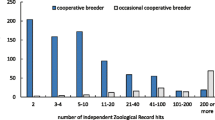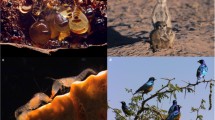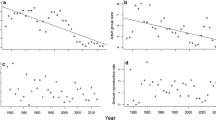Summary
Australia has many cooperatively breeding species of birds. These tend to occur in eucalypt and semi-arid woodlands rather than in rainforests or deserts. They tend to be insectivores that pursue rather than sit and wait for their prey, and tend to forage on the ground rather than above it. We propose that environments where resources do not show marked seasonal fluctuations are those in which cooperative breeding is most likely to evolve. Under these conditions birds might experience difficulty acquiring the extra food necessary to breed, especially if inexperienced. When adult survival was high, young and inexperienced birds could delay breeding. Unpredictable environments may also favor cooperative breeding, but our data do not strongly support this. Groupliving would be favored further if young birds are particularly vulnerable to predators when alone. They should therefore remain in the family group and delay their dispersal unitl a suitable breeding vacancy becomes available. These hypotheses are not mutually exclusive, but are complementary. Both may be required to ensure that at least some year-old birds do not breed and also do not disperse. We believe that they give rise to predictions, which can be tested in future field studies.
Similar content being viewed by others
References
Ambrose SJ (1985) Aspects of the physiological and behavioural ecology of the white-browed scrubwren Sericornis frontalis (Aves-Acanthizidae) in Western Australia. PhD Thesis, University of Western Australia
Bell HL (1982) Cooperative breeding by the white-browed scrub-wren Sericornis frontalis. Emu 82:315–316
Bell HL (1983) Resource partitioning between three syntopic thornbills (Acanthizidae: Acanthiza Vigors & Horsfield). PhD Thesis, University of New England, Armidale, NSW
Bell HL (1985) Seasonal variation and the effects of drought on the abundance of arthropods in savanna woodland on the Northern Tablelands of New South Wales. Aust J Ecol 10:207–221
Bell HL, Ford HA (1986) A comparison of the social organization of three syntopic species of Australian thornbill Acanthiza. Behav Ecol Sociobiol 19:381–392
Blakers M, Davies SJJF, Reilley PN (1984) The atlas of Australian birds. Melbourne Univ Press, Melbourne
Borgia G (1985) Bower quality, number of decorations and mating success of male satin bowerbirds (Ptilinorhynchus violaceus): an experimental analysis. Anim Behav 33:266–271
Brown JL (1969) Territorial behavior and population regulation in birds. Wilson Bull 81:293–329
Brown JL (1974) Alternate routes to sociality in jays — with a theory for the evolution of altruism and communal breeding. Am Zool 14:63–80
Brown JL (1978) Avian communal breeding systems. Ann Rev Ecol Syst 9:123–155
Brown JL (1980) Fitness in complex avian social systems. In: Markl H (ed) Evolution of social behaviour: hypotheses and empirical tests. Dahlem Konferenzen. Weinheim, Verlag Chemie, pp 115–128
Brown JL (1987) Helping and communal breeding in birds: Ecology and evolution. Princeton University Press, Princeton, NJ
Cameron E (1985) Habitat usage and foraging behaviour of three fantails (Rhipidura: Pachycephalidae). In: Keast JA, Recher HF, Ford HA, Saunders D (eds) Birds of eucalypt forests and woodlands: ecology, conservation, management. Surrey Beatty, Syndney, pp 177–191
Clarke MF (1984) Cooperative breeding by the Australian bell miner Manorina melanophrys Latham: A test of kin selection theory. Behav Ecol Sociobiol 14:137–146
Counsilman JJ (1980) A comparison of two populations of the grey-crowned babbler. Part 2. Bird Behaviour 2:1–109
Dow DD (1978) Reproductive behavior of the noisy miner, a communally breeding honeyeater. Living Bird 16:163–185
Dow DD (1980) Communally breeding Australian birds with an analysis of distributional and environmental factors. Emu 80:121–140
Emlen ST (1982a) The evolution of helping. I. An ecological constraints model. Am Nat 119:29–39
Emlen ST (1982b) The evolution of helping. II. The role of behavioral conflict. Am Nat 119:40–53
Emlen ST, Demong NJ (1980) Bee-eaters: an alternative route to cooperative breeding. Proc XVII Int Ornithol Congr (Berlin), pp 895–902
Ford HA (1979) Interspecific competition in Australian honeyeaters — depletion of common resources. Aust J Ecol 4:145–164
Ford HA (1983) Relation between number of honeyeaters and intensity of flowering near Adelaide, South Australia. Corella 7:25–31
Ford HA, Noske S, Bridges L (1986) Foraging behaviour of birds in cucalypt woodland in north-eastern New South Wales. Emu 86:168–179
Ford HA, Pursey JF (1982) Status and feeding of the eastern spinebill Acanthorhynchus tenuirostris at New England National Park, north-eastern NSW. Emu 82:203–211
Fry CH (1977) The evolutionary significance of cooperative breeding in birds. In: Stonehouse B, Perrins CM (eds) Evolutionary ecology. Macmillan, London, pp 127–135
Gaston AJ (1978) The evolution of group territorial behavior and cooperative breeding. Am Nat 112:1091–1100
Gaston AJ (1984) Cooperative breeding. In: Campbell BC, E. Lack (eds) A Dictionary of Birds. Poyser, Calton, Staffs, England, pp 108–109
Grimes LG (1976a) The occurrence of cooperative breeding behaviour in African birds. Ostrich 47:1–15
Grimes LG (1976b) Cooperative breeding in African birds. Proc XVI Int Ornithol Congr (Canberra, Australia), pp 667–673
Harrison, CJO (1969) Helpers at the nest in Australian passerine birds. Emu 69:30–40
Huddy L (1979) Social behaviour and feeding ecology of scarlet robins Petroica multicolor. Hons Thesis, University of New England, Armidale, NSW
Huey RB, Pianka ER (1981) Ecological consequences of foragiag mode. Ecology 62:991–999
Keast JA, Recher HF, Ford H, Saunders D (1985) Birds of eucalypt forests and woodlands: ecology, conservation, management. RAOU and Surrey Beatty, Sydney
Kikkawa J (1980) Seasonality of nesting in zebra finches at Armidale, NSW. Emu 80:13–20
Koenig WD, Pitelka FA (1981) Ecological factors and kin selection in the evolution of cooperative breeding in birds. In: Tinkle D, Alexander R (eds) Natural selection and social behaviour. Chiron Press, New York, pp 261–280
Ligon JD, Ligon SH (1983) Reciprocity in the green woodhoopoe (Phoeniculus purpureus). Anim Behav 31:480–489
Lowman MD (1982) Seasonal variation in insect abundance among three Australian rainforests, with particular reference to phytophagous types. Aust J Ecol 7:353–363
Marshall AJ (1954) Bower-Birds. Their displays and breeding cycles. Clarendon Press, Oxford
Nias R (1987) Cooperative breeding in the superb fairy-wren Malurus cyaneus. PhD Thesis, University of New England, Armidale, NSW
Nix HA (1976) Environmental control of breeding, post-breeding dispersal and migration of birds in the Australian region. Proc XVI Int Ornithol Congr (Canberra, Australia). pp 272–305
Noske RA (1983a) Communal behavior of brown-headed honeyeaters. Emu 83:38–41
Noske RA (1983b) Comparative behaviour and ecology of some Australian bark-foraging birds. PhD Thesis, University of New England, Armidale, NSW
Orians GL, Orians CE, Orians KJ (1977) Helpers at the nest in some Argentine blackbirds. In: Stonehouse B, Perrins CM (eds) Evolutionary Ecology. Macmillan, London, pp 137–151
Parr SJ (1985) The breeding ecology and diet of the hobby Falco subbuteo in southern England. Ibis 127:60–73
Paton D (1985) Food supply, population structure and behaviour of New Holland honeyeaters Phylidonyris novaehollandiae in woodland near Horsham, Victoria. In: Keast JA, Recher HF, Ford HA, Saunders D (eds) Birds of eucalypt forests and woodlands: ecology, conservation, management. RAOU and Surrey Beatty, Sydney, pp 219–230
Pulliam HR (1973) On the advantage of flocking. J Theor Biol 38:419–422
Pyke GH (1980) Foraging behaviour of Australian hoeyeaters: A review and some comparisons with hummingbirds. Aust J Ecol 5:343–370
Pyke G (1985) The relationships between abundances of honeyeaters and their food resources in open forests near Sydney. In: Keast JA, Recher HF, Ford HA, Saunders D (eds) Birds of eucalypt forest and woodland: ecology, conservation, management. RAOU and Surrey Beatty, Sydney, pp 65–77
Raitt RJ, Hardy JW (1979) Social behavior, habitat and food of the Beechey jay. Wilson Bull 91:1–15
Recher HF, Gowing G, Kavanagh R, Shields J, Rohan-Jones W (1983) Birds, resources and time in a tableland forest. Proc Ecol Soc Aust 12:101–123
Recher HF, Holmes RT, Schulz M, Shields, J, Kavanagh R (1985) Foraging patterns of birds in eucalypt forest and woodland on the tablelands of south-eastern Australia. Aust J Ecol 10:399–420
Ricklefs RE (1980) Watchdog behaviour observed at the nest of a cooperative breeding bird, the rufous-margined flycatcher Myiozetetes cayanensis. Ibis 122:116–118
Ridpath MG (1985) Ecology in the wet-dry tropics: how different? Proc Ecol Soc Aust 13:3–20
Rowley I (1962) “Rodent run” distraction display by a passerine, the superb blue wren Malurus cyaneus L. Behaviour 19:170–176
Rowley I (1968) Communal species of Australian birds. Bonn Zool Beitr 19:362–370
Rowley I (1976) Cooperative breeding in Australian birds. Proc XVI Int Ornithol Congr, Canberra, Australia, pp 657–666
Rowley I (1978) Communal activities among white-winged choughs Corcorax melanorhamphus. Ibis 120:178–197
Sibley CG, Ahlquist JE (1985) The phylogeny and classification of the Australo-Papuan passerine birds. Emu 84:1–14
Thomas DG (1974) Some problems associated with the avifauna. In: Williams WD (ed) Biogeography and ecology of Tasmania. Junk, The Hague, pp 339–365
Trail PW (1980) Ecological correlates of social organization in a communally breeding bird, the acorn woodpecker Melanerpes formicovorus. Behav Ecol Sociobiol 7:83–92
Vogel C (1985) Helping, cooperation and altruism in primate societies. In: Hölldobler B, Lindauer M (eds) Experimental behavioral ecology and sociobiology. Fischer Stuttgart, pp 375–389
Woinarski JCZ (1985) Breeding biology and life history of small insectivorous birds in Australian forests: response to a stable environment? Proc Ecol Soc Aust 14:159–168
Woinarski JCZ, Cullen JM (1984) Distribution of invertebrates on foliage in forests of south-eastern Australia. Aust J Ecol 9:207–232
Woolfenden GE, Fitzpatrick JW (1984) The Florida scrub jay: Demography of a cooperative-breeding bird. Princeton University Press, Princeton, NJ
Wyndham E (1980) Environment and food of the budgerigar Melopsittacus undulatus. Aust J Ecol 5:47–61
Zack S, Ligon JD (1985) Cooperative breeding in Lanius shrikes. I. Habitat and demography of two sympatric species. Auk 102:754–765
Author information
Authors and Affiliations
Rights and permissions
About this article
Cite this article
Ford, H.A., Bell, H., Nias, R. et al. The relationship between ecology and the incidence of cooperative breeding in Australian birds. Behav Ecol Sociobiol 22, 239–249 (1988). https://doi.org/10.1007/BF00299838
Received:
Accepted:
Issue Date:
DOI: https://doi.org/10.1007/BF00299838




